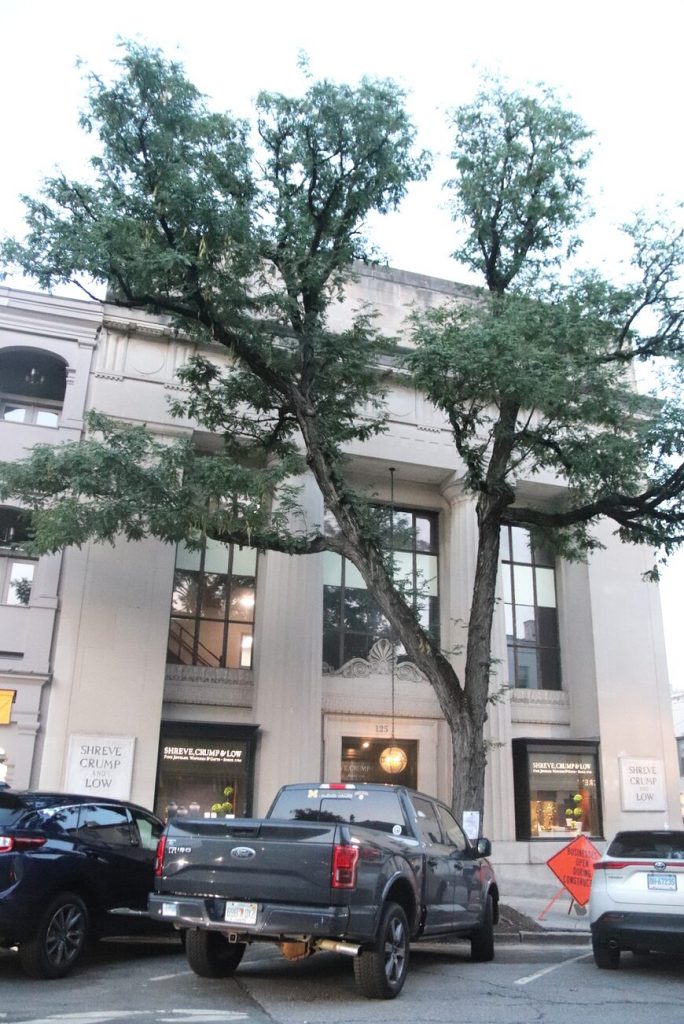
A big “Thank You!” to the Woman’s Club of Greenwich for your generous award in support of our mission.
Click here to read about it on page 6 of this week’s issue of the Greenwich Sentinel.

A big “Thank You!” to the Woman’s Club of Greenwich for your generous award in support of our mission.
Click here to read about it on page 6 of this week’s issue of the Greenwich Sentinel.
The Greenwich Tree Conservancy Board of Directors is thrilled to announce the election of John R. Conte, RLA, ASLA, as the new president of the Board of Directors. With over 40 years of experience in arboriculture, landscape architecture and construction, Conte brings a wealth of expertise to the GTC and a deep commitment to preserving and enhancing Greenwich’s natural beauty.
 Beyond his professional accomplishments, Conte has been highly involved in the Greenwich community for many years. He has previously served on the boards of the Greenwich Land Trust, Greenwich Audubon, and Family Centers Inc, and has extensive leadership experience as president of the board of the Round Hill Association and Greenwich Green & Clean.
Beyond his professional accomplishments, Conte has been highly involved in the Greenwich community for many years. He has previously served on the boards of the Greenwich Land Trust, Greenwich Audubon, and Family Centers Inc, and has extensive leadership experience as president of the board of the Round Hill Association and Greenwich Green & Clean.
Click here to read the full press release on the Greenwich Free Press.
From the Greenwich Patch, October 29th:
“GREENWICH, CT — At long last, Greenwich will plant 100 trees along the Post Road corridor from Port Chester, N.Y., to Stamford in an effort to create a tree-lined gateway into New England.
An inaugural planting event will take place at 11:30 a.m. at 600 East Putnam Ave. in Cos Cob on Nov. 1. Up to 90 of the approved trees will go in the ground, and the remaining trees will be planted in the spring.
“This effort was one of the things I pledged to work on back in 2019 and found very willing partners in Planning & Zoning, DPW, the Tree Conservancy and others who led the way,” First Selectman Fred Camilo told Patch. “Having a tree-lined boulevard running through the middle of our town will be the first thing that many visitors see when they pass through Greenwich and what a beautiful sight it will be. It is something that will live beyond our lives and enrich the lives of those who come after us.”
Read the full story at Greenwich To Plant 100 Trees Along Post Road Corridor | Greenwich, CT Patch
Over 90% of American households own at least one car, and in Connecticut 77% of residents drive to work. Parking lots are ubiquitous in Greenwich but they do not have to be eyesores.
Since 2018, the Greenwich Tree Conservancy has prioritized the greening of town parking lots. This summer they have planted 14 additional trees in the William Street and Henry Street parking lots in Byram as part of their “Parking Parks” initiative.

Unshaded pavement can be up to 45° F hotter than shaded areas, significantly contributing to the heat island effect seen in urban spaces. One of the simplest yet most effective methods to combat this problem is by planting trees. The shade provided by trees helps keep parking lots and cars cooler, but they also provide many other benefits to human health and the environment.
Click here to read the full press release on Greenwich Free Press.
 From the Greenwich Time:
From the Greenwich Time:
The Greenwich Tree Conservancy has planted trees at two parking lots in town in an effort to beautify the spaces and provide shade for sunny days.
The conservancy has been “greening” parking lots around town since 2018. This summer they planted 14 new trees at lots on William Street in Central Greenwich and Henry Street in Byram.
The conservancy works with Greg Kramer, the town’s tree warden, to select the right trees for each place.
“Parking lots are challenging environments for trees and Dr. Kramer selects ornamental and shade trees that suit a neighborhood’s aesthetics and can withstand the heat, air pollution and de-icing salts they may be exposed to,” the conservancy wrote in a press release.
In addition to providing shade, the trees also reduce water runoff from paved areas and improve air quality.
Read the full story at https://www.greenwichtime.com/news/article/greenwich-party-with-police-trees-autistic-19654939.php
By Chery Dunson and Sue Baker, Advisory Board Chairs

Greenwich is fortunate to have an extensive tree canopy providing a vivid and kaleidoscopic display of color and form throughout our spring, summer and fall seasons. Trees line our streets. They stand in our parks, on our school grounds, and make up our woodlands. They adorn the yards around our homes. Trees provide benefits to town residents by shielding us from heat and cold, purifying our air and water and significantly reducing stormwater flooding. They soften the noise from ever increasing traffic and the visual impact of our urban built environments. Along with all this they provide food and shelter essential to birds and other wildlife.
Among the many thousands, there are exceptional trees notable for their great size, unusual species or historic or social significance. In the 1980s, the Connecticut College Arboretum established the statewide Notable Tree program, surveying towns across Connecticut. The program identified over 100 notable trees on public and private lands in Greenwich. If you are interested in learning more about the Connecticut College Arboretum Notable Trees project you can visit – http://oak.conncoll.edu:8080/notabletrees/
Until recently, the status of many of the Greenwich listed trees was unknown. Throughout the past year, the Greenwich Tree Conservancy has located many of these trees providing an update of the town’s listing. We have determined if the trees are still alive and healthy, their current size and status, or if they had been removed.
The process is straightforward. We reach out to property owners requesting permission to access their property to verify the status of the tree. A team of three volunteers locates each tree and takes measurements to determine the diameter of its trunk, the spread of its crown, and its overall height. Each of these measurements contributes to an overall rating as established by American Forestry Association. This information is provided to the CT College Arboretum in order to update the Greenwich listing. Among our town’s Notable Trees are Oaks, Horse Chestnuts, American Sycamores, London Planetrees and Japanese Zelkovas.
To date, we have verified the status of all the notable trees on public lands. Additionally, half of the private property owners have granted us access. We would like to thank the numerous property owners who beyond granting us access have enabled these notable trees to survive and thrive over the decades!
Some verified notable trees you can look for on public lands include a Sweetgum (Liquidamber styraciflua), Swamp White Oak (Quercus bicolor) and Black Oak (Quercus velutina) in Bruce Park. A London Planetree (Platanus acerifolia) at the Board of Education building at 290 Greenwich Avenue. A Thread Leaf Japanese Maple (Acre palmatum‘Dissectum’ ), Monkey Puzzle Tree (Araucaria araucana), Thayer Yew (Taxus media ‘Thayerae’) and Sargent’s Weeping Hemlock (Tsuga canadensis ‘Sargentii’) in the Montgomery Pinetum in Cos Cob. An American Sycamore (Platanus occidentalis) at North Mianus School and a Horse Chestnut (Aesculus hippocastanum) on Sound Beach Avenue in Old Greenwich.
This is an ongoing project for the Tree Conservancy and we are now turning our attention to adding new trees to the CT College Notable Tree listing for Greenwich. If you have a tree on your property that you believe may be notable for its size, species or historic significance, or if you delayed responding to our letter, you may contact us at: arboretum@greenwichtreeconservancy.com.
To find out more about the Greenwich Tree Conservancy, visit us at: www.greenwichtreeconservancy.org.
We look forward to hearing from you!
Last Thursday Greenwich’s superintendent of Parks & Trees/Tree Warden, Dr. Greg Kramer held a zoom public hearing about a mature Honey Locust tree at 125 Greenwich Ave requested by the owner of Shreve Crump & Low to be cut down because its roots were impacting the sidewalk.
The tree, “Gleditsia Triacanthos” has a DBH (diameter at breast height) of 26 inches.
The tree is in front of Shreve Crump & Low.

First Selectman Fred Camillo testified that the issue with the sidewalk was a trip hazard and urged the tree be replaced.
Kate Dzikiewicz, director of the Greenwich Tree Conservancy, and the former director JoAnn Messina, as well as board chair Peter Malkin all spoke in favor of sparing the tree and figuring out a workaround.
Ms Messina the new Belgian block lined tree wells in the sidewalks all along Greenwich Avenue were a trip hazard.
Ms Dzikiewicz said the Tree Conservancy could assist with expenses of analyzing the tree roots and possibly installing ramps.
Several town residents also urged the tree warden to spare the tree.
[Story continues – read the full article at https://greenwichfreepress.com/news/government/town-tree-warden-rules-sympathetically-to-decades-old-honey-locust-on-greenwich-ave-220399/ ]

Read the article on page 3 of the digital newspaper at GreenwichSentinel-5-10-24.pdf

A great op ed written by Margaret Renkl titled “Why Aren’t We Saving the Urban Forests?” was featured in the NY Times on April 22nd.
 Arhaus, an artisan-crafted furniture company, has opened a new 5,300 square foot showroom in Greenwich.
Arhaus, an artisan-crafted furniture company, has opened a new 5,300 square foot showroom in Greenwich.
“In celebration of the Greenwich showroom opening and in support of its ongoing Green Initiative, Arhaus will make a $10,000 contribution to The Greenwich Tree Conservancy Inc., a nonprofit organization dedicated to preserving and enhancing the tree and forest resources of Greenwich. To learn more about The Greenwich Tree Conservancy Inc., visit GreenwichTreeConservancy.org.”
Read the full press release at Arhaus Announces Showroom Opening in Greenwich, Connecticut.
Thank you, Arhaus, for your generous contribution.
Arhaus is located at 45 East Putnam Avenue, Greenwich, CT.